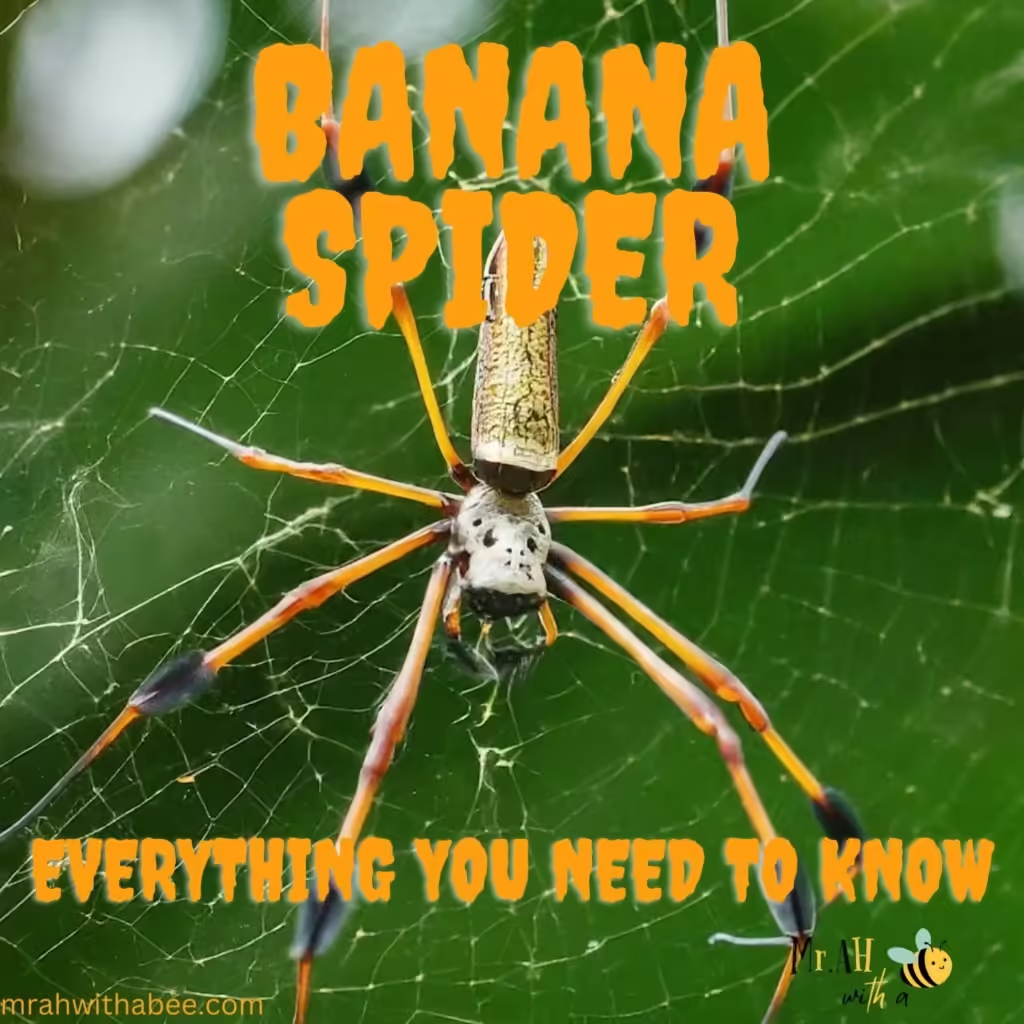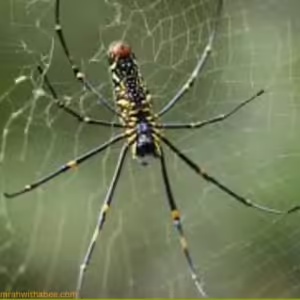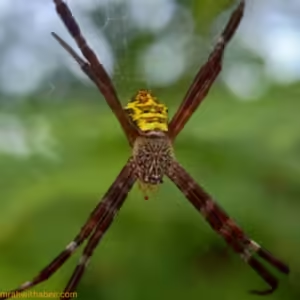Many people mistake banana spiders due to their large size and prominent appearance. Although some consider them dangerous, especially in pest control, these arachnids play a valuable role in ecosystems. Allowing us to appreciate their importance in nature, banana spiders can help dispel fears.
Table of Contents
Toggle
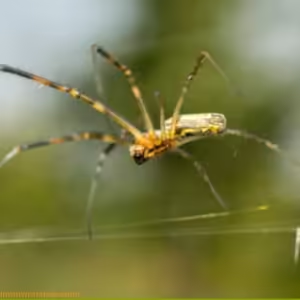
Identification
Banana spiders belong to the genus Nephila and are known for their huge size and golden-colored webs. Although they are different in appearance, they are generally medium to large in size, with females growing larger than males. They consist of long slender legs, typically with black and yellow coloring, and a unique, elongated abdomen.
On the other hand, female banana spiders are more notable, measuring between 1 to 3 inches, while males are smaller and less colorful. They can be found in warm climates like the southeastern United States especially in Florida, as well as tropical and subtropical regions around the world. They can find a stable food source where their preferred habitats include forests, gardens, and even urban areas.
Types of Banana Spiders and Their Differences
There are various spiders commonly known as “banana spiders,” each belonging to different genera and possessing distinct traits. Below is an overview of the primary types of banana spiders and how they differ from one another:
Golden Silk Orb-Weaver (Genus: Nephila)
Golden Silk Orb-Weaver, also known as Nephila clavipes (common in the Americas) and other Nephila species in Asia and Africa. Their females are large, with a body that can reach up to 3 inches in length. They are yellow or golden-colored bodies with long, thin legs often banded with black and yellow. They are known for their spectacular golden silk webs, which can reach several feet.
These spiders thrive in warm regions, especially in the southeastern United States, and tropical areas in Central and South America, Asia, and Africa. While their venom is mildly irritating to humans, bites are generally not dangerous. Their diet is primarily insects, they can help control populations of flies, mosquitoes, and beetles. Overall, they contribute positively to their ecosystems.
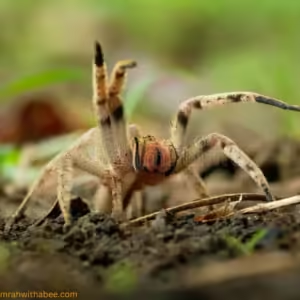
Brazilian Wandering Spider (Genus: Phoneutria)
Brazilian Wandering Spider, scientifically known as Phoneutria nigriventer, is notable for its larger body, with a leg span reaching up to 5-6 inches. They are brown with dark, hairy bodies and long, strong legs. These spiders are ground-dwelling hunters, and do not spin a traditional web, which sets them apart from other banana spiders.
They are commonly found in South and Central America, often close to areas where humans live. While they are highly venomous with a potent neurotoxin, their bite can be medically serious. Their bites are rare and commonly accidental. Their diet consists of insects, small mammals, and other small prey, making them effective predators in their ecosystems.
Hawaiian Garden Spider (Genus: Argiope)
The Hawaiian Garden Spider, also known by its genus name Argiope, is notable for its large females, which can exceed one inch in size. These spiders are characterized by their striking bright yellow and black markings. They often create circular and intricate webs, which may feature a zigzag pattern known as a stabilimentum.
These spiders are native to Hawaii and can be found throughout the Pacific Islands. They are non-dangerous to humans; while their venom is used to subdue prey, it is harmless to people. Their diet consists primarily of insects, which they trap in their webs to feed on. Overall, they play a beneficial role in their ecosystems by controlling insect populations.
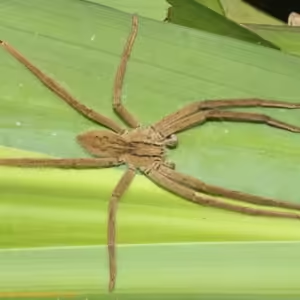
Cupiennius Spider (Genus: Cupiennius)
Cupiennius Spider, scientifically also known as Cupiennius is often confused with Brazilian wandering spiders due to their similar appearance and size, yet they are less dangerous. They are brown with strong hairy legs. It’s an ambush predator and does not spin a web for catching insects.
These spiders are commonly found in Central America and are often confused with the Brazilian wandering spider because they inhabit similar environments. They are mildly venomous but pose no threat to humans; their bites are usually mild and heal quickly. Their diet includes a variety of insects and other small creatures, which makes them effective predators within their ecosystems. The venom of Cupiennius spiders, particularly Cupiennius salei and Cupiennius chiapanensis, exhibits significant biological effects, primarily characterized by cytotoxic and neurotoxic properties. While these venoms are primarily adapted for prey capture, their potential impact on humans is a subject of interest, particularly regarding toxicity and antimicrobial properties. Despite the potential for harmful effects, there is limited evidence of serious envenomation cases in humans, indicating that while the venom is toxic to smaller prey, its impact on humans may be less severe (Villavicencio .
Behavior and Diet
People recognize banana spiders for their web-building abilities. They spin large and tangled webs that can reach up to six feet in diameter. The name ” Golden Banana Spider” derives from their webs that are often golden. To trap insects like flies, mosquitoes, and beetles, they build these webs trap, which make up the bulk of their diet. Their contributions to natural pest management, which is especially beneficial in agriculture and garden settings by controlling their population.
In addition, banana spiders employ a unique technique to capture their prey using their web-building skills. Once they catch an insect in their web, they quickly immobilize to use their venom before consuming it.
Venom and Safety
The venom of some banana spiders is not dangerous to humans, but they are still venomous. Similar to a bee sting, it may cause mild irritation, swelling, or redness, but it generally doesn’t require medical attention. They are relatively harmless and would rather avoid human contact, but common misconceptions suggest that banana spiders are deadly.
However, people usually get bitten by a banana spider after accidentally pressing against it or disturbing its web. In such cases, washing the area with soap and water, applying ice, and taking over-the-counter pain relief is usually sufficient.
The venom of the banana spider, scientifically known as Phoneutria nigriventer, poses significant risks to humans due to its potent neuroactive components. Envenomation can lead to severe symptoms, including priapism, hypertension, and vomiting, with approximately 4,000 incidents reported annually in Brazil (Cardoso et al., 2022)(Cardoso et al., 2023). The complexity of its venom, which contains a diverse array of neuroactive peptides, contributes to its lethality and potential therapeutic applications.
- Neuroactive Peptides: P. nigriventer venom includes at least 27 novel cysteine-rich peptides that modulate ion channels, affecting sodium and calcium channels and nicotinic acetylcholine receptors.
- Clinical Symptoms: Symptoms of envenomation can range from mild to life-threatening, with priapism being a notable effect due to the venom’s action on vascular systems.
Despite the dangers posed by P. nigriventer, fatalities from spider bites have significantly decreased over the past few decades, indicating improvements in medical response and awareness (Nentwig & Kuhn-Nentwig, 2013). This highlights the importance of understanding spider venoms not only for public health but also for their potential in pharmacology.
Life Cycle
Banana spiders experience a life cycle that includes three stages: egg, juvenile, and adult. In the fall, females lay their eggs in a silk sac and attach them to a secure part of their web. After a few weeks, the eggs hatch, and young spiders grow and molt for several months before becoming adults. These spiders generally live for about a year, being most active during the warmer months and less so in the colder seasons.
During mating season, males will approach the larger females cautiously to avoid being mistaken for prey. After mating, males often die or become a food source for the female, while the female focuses on laying her eggs.
Cultural Significance
In regions where people commonly find them, banana spiders hold a significant place in folklore and culture. Some of the Southeast Asian and Pacific Island cultures, people regard banana spiders as symbols of creativity and patience due to their impressive web-spinning skills. In other stories, people depict them as tricksters or protectors, reflecting the respect and fascination they inspire in various communities.
The art and literature of banana spiders, often represent nature’s intricate beauty and resilience. Certain cultures have even used their golden webs to produce unique textiles, showcasing the spiders’ significance in the creative arts.
Benefits to Humans
Banana spiders play a vital role in pest control by preying on insects that may damage crops or cause disturbances in gardens and homes. By regulating insect populations, they help maintain ecological balance, promote plant growth, and prevent pest infestations.
Beyond their role in pest control, banana spiders play a crucial part in fostering biodiversity and serve as essential contributors to their ecosystems. Their presence supports other beneficial predators and helps maintain a stable food chain.
Conclusion
Banana spiders play a vital role in our ecosystems by providing natural pest control and contributing to biodiversity. Contrary to common misconceptions, they are harmless and even beneficial to humans. By learning more about these unique spiders, we can better appreciate their role in nature and strive to coexist with them peacefully.
FAQs
Are banana spiders dangerous to humans?
No, banana spiders are generally harmless to humans. Their venom is mild and does not pose serious health risks.
How can I identify a banana spider?
Look for a large spider with black and yellow coloring, long legs, and a golden web. Females are larger than males and have a more distinct color pattern.
What should I do if I find a banana spider in my home?
Gently relocate the spider outdoors, if possible, using a container. They’re harmless and beneficial, so there’s no need to kill them.
Do banana spiders make good pets?
People do not commonly keep banana spiders as pets because of their specific habitat needs and web-building behaviors. They are best observed in the wild.
Where are banana spiders commonly found?
You can find banana spiders in warm climates, including the southeastern United States, tropical regions, and areas with forests, gardens, or tall vegetation.
Are banana spiders the same as golden orb-weaver spiders?
Yes, banana spiders are a type of golden orb-weaver, known for their yellow-gold webs and long, slender bodies.
Can a banana spider bite kill a pet?
Banana spider bites are not fatal to pets. However, if a pet has an allergic reaction, it’s best to consult a veterinarian.
How do banana spiders help control pests?
Banana spiders eat a variety of insects, including flies and mosquitoes, helping to reduce pest populations naturally.
Are banana spiders active year-round?
No, they are most active during warmer months. Their activity decreases in colder seasons, and they may not survive freezing temperatures.
Do banana spiders spin webs every day?
Banana spiders typically repair and maintain their webs daily, and they may relocate or rebuild if they damage their web.

